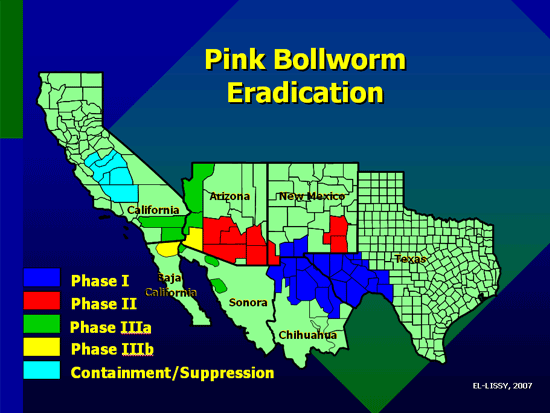Pink Bollworm Eradication Program: Informational Video
National Cotton Council February, 2009
Objective: To eradicate the pink bollworm from all cotton-producing areas of the U.S. and adjacent areas of northern Mexico. The pink bollworm is costing U.S. cotton producers more than $32 million each year in control costs and yield losses. To eliminate this annual burden, in 2002, the industry began Phase I of a program to eradicate this key cotton pest.

Timeline & Program Areas: This is a grower-driven program, therefore expansion (as described in the map) has advanced only upon passage of grower referenda.
Technology: The technology used to eradicate the pink bollworm has four primary components: 1) extensive survey; 2) transgenic Bt cotton; 3) pheromone application for mating disruption; and, 4) sterile pink bollworm moth releases. Program technologies are applied on an area-wide basis, and continue over a four-to-five-year period. The first year, or possibly two years, will combine grower-planted Bt cotton, survey trapping and pheromone applications for mating disruption. The remainder of the program includes use of Bt cotton, pheromones and daily releases of sterile insects to complete eradication of pink bollworm.
Projected Costs: Grower approved assessments pay for program operations, trapping and pheromone applications. Planting Bt cotton is encouraged, but it is the grower’s decision. The cost of Bt cotton is a grower expense, but assessments on Bt cotton acres are reduced by the technology fee amount. The cost of sterile insect rearing and daily releases are provided by USDA APHIS as cost-share to the program. The facility used for the rearing operations was paid for by California Cotton Producers and belongs to the California Department of Food and Agriculture. In general, complete program costs result in approximately an 80% cost-share provided by growers and 20% federal dollars.
Current Status: As a result of eradication program activities using Bt cotton and mating disruption pheromones during 2003, the pink bollworm moth population across Phase I of the program was reduced by 87 to 96 % from 2001 to 2003. Larval infestations in bolls were reduced by nearly 90 % in Texas and were <1 % in NM and Chihuahua, Mexico. With population reductions on target, the next technology deployed was sterile pink bollworm moth releases during the 2005 season. Expansion of the program was slowed during 2006 and 2007 due to budget constraints limiting the availability of sterile moths. During this time, pheromone trap captures demonstrated large numbers of moths moving across desert land to re-infest program areas. The need for complete expansion was realized in order to protect program success thus far. As of 2008, all U.S. zones had approved grower referendums and initiated Pink Bollworm Eradication Programs. Similarly, adjacent areas of Mexico with Pink Bollworm infestations in cotton were included in the program. The program expanded through all U.S. zones. As a result, the last moth capture was documented in 2013. The technical advisory committee recommended several years of no sterile release but maintain trap monitoring to ensure success. Additionally, other areas of Texas and New Mexico were trapped to verify absence of Pink Bollworm populations. With no Pink Bollworm captures thus far, declaration of eradication draws near.

